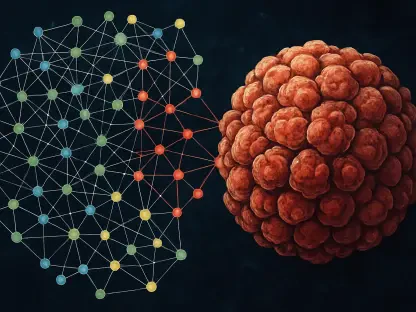The realm of advanced materials has witnessed a groundbreaking development with the introduction of molecular chainmail by researchers at Westlake University. Led by Professor Zhichang Liu, this innovative work in polymer science has resulted in a two-dimensional (2D) mechanically interlocked polymer (MIP) that mimics medieval chainmail on a micrometer scale. This new material, which boasts a unique combination of high flexibility and stiffness, promises revolutionary applications in next-generation lightweight protective gear and smart armor systems.
Synthesis and Structure of the 2D MIP
A New Era in Polymeric Materials
Published in the journal Nature Synthesis and titled “Synthesis of a crystalline two-dimensional [c2]daisy chain honeycomb network,” the study delves into the synthesis of a purely organic crystalline 2D MIP with long-range order. The innovative material comprises 3 billion [c2]daisy chain units per square centimeter, each behaving like interlocking rings. These units enable the polymer to bend without breaking while maintaining exceptional stiffness, mimicking the structure and function of medieval chainmail on a microscopic scale.
Each [c2]daisy chain unit consists of a macrocycle and an axle that interpenetrate, resulting in two distinct mechanical bonds. This configuration addresses the longstanding trade-off between flexibility and rigidity in MIPs. Typically, rigid materials crack under stress, while flexible gels deform irreversibly. This new material, however, combines the best properties of rigid and flexible polymers, functioning like a microscale bulletproof fabric. This unique combination of traits is the result of a careful and innovative synthesis approach.
Innovative Synthesis Strategy
The research team employed a synergistic strategy combining crystallization preorganization and post-interlocking techniques. Initially, they used flexible tritopic monomers, organizing them into a long-range ordered honeycomb network. Through the application of light, they achieved mechanical interlocking, thereby creating a flat, interlocked structure. Unlike previous methods that relied on tangling linear polymer chains, this approach used symmetrical three-armed monomers, which ensured the mechanical stability of the material without depending on chemical bonds.
This methodological advancement was facilitated by synchrotron radiation techniques. The team serendipitously discovered that their initial aim of creating a molecular cage resulted in forming a honeycomb network. This outcome was due to the high flexibility and scalability of the [c2]daisy chain monomers. The hierarchical assembly process, from monomers to dimers, hexamers, and ultimately honeycomb networks, proved crucial. These networks were then stacked into hexagonal prisms, and photoinitiated thiol-ene click chemistry transformed the pseudo-[c2]daisy chain into fully interlocked units via complementary non-covalent interactions.
Properties and Potential Applications
Exceptional Flexibility and Stiffness
The bulk crystals of this novel polymer could be peeled into ultrathin layers, presenting an impressive finding—these layers were 47 times stiffer than the original bulk material, while still maintaining structural symmetry. This counterintuitive discovery challenges conventional assumptions that thinner materials are inherently weaker, thereby likening the material to molecular chainmail—rigid yet flexible.
Currently, the research team is testing the material’s response to various stimuli, including heat, pressure, and pH changes. This in-depth analysis aims to further understand the material’s behavior under different conditions, providing critical insights into its practical applications. The results from these tests could offer invaluable data for developing advanced protective gear that adapts to varying environments and conditions.
Future of Smart Armor Systems
The implications of this research are vast. The development of molecular chainmail could pave the way for significant advancements in protective and adaptive materials. The ability to create armor that hardens on impact, combined with the material’s lightweight nature, has the potential to revolutionize smart armor systems. This innovation could lead to the production of body armor, helmets, and other protective gear that is both lighter and more resilient than current offerings, enhancing safety and comfort for users.
Military and law enforcement personnel, in particular, stand to benefit tremendously from such advancements. By utilizing materials that are more flexible and comfortable while offering superior protection, the overall effectiveness and wearability of their gear could be significantly improved. Additionally, applications in civil engineering, automotive, and aerospace industries could see groundbreaking changes as well, providing enhanced safety and performance across various sectors.
Exploration and Future Directions
Broadening Research Horizons
As this field of polymer science continues to evolve, the potential for new and innovative materials grows. Professor Liu and his team are at the forefront of this research, exploring additional properties and functions of their 2D MIP. Their ongoing studies aim to unlock further capabilities of the material, such as its potential self-healing properties, adaptability to diverse environments, and integration into more complex systems. Each new discovery contributes to a broader understanding of the material’s full range of applications.
Future research could also focus on scaling up the production of these innovative materials, addressing potential challenges in manufacturing processes, and ensuring their viability for commercial use. By overcoming these challenges, the gap between laboratory research and real-world applications can be bridged, bringing these advanced materials closer to everyday use.
Potential Challenges and Considerations
Despite the promising outlook, there are potential challenges and considerations that need to be addressed. The durability of these materials over extended periods and their long-term resilience under continuous stress are critical factors that require thorough investigation. Additionally, the economic feasibility of producing such materials on a large scale is another important aspect that needs careful evaluation.
Environmental considerations also play a crucial role. The lifecycle of these materials, their recyclability, and their environmental impact must be scrutinized to ensure that the advancements in polymer science contribute positively to sustainability efforts. Addressing these challenges will require a multidisciplinary approach, involving experts from various fields to develop comprehensive solutions.
The Road Ahead
Westlake University researchers have achieved a significant breakthrough in advanced materials with the creation of molecular chainmail. Under the leadership of Professor Zhichang Liu, their innovative work in the area of polymer science has led to the development of a two-dimensional (2D) mechanically interlocked polymer (MIP). This cutting-edge material, which resembles medieval chainmail but on a micrometer scale, demonstrates a remarkable blend of flexibility and stiffness.
The advent of this new material is poised to have a transformative impact on various applications, particularly in the domain of next-generation lightweight protective gear and smart armor systems. Its unique properties suggest it can provide enhanced protection while remaining light and comfortable, characteristics that are crucial for modern protective equipment. This advancement opens exciting possibilities for the creation of highly durable and adaptable materials, leading to potential innovations in safety, military, and even aerospace applications where both flexibility and toughness are required.









